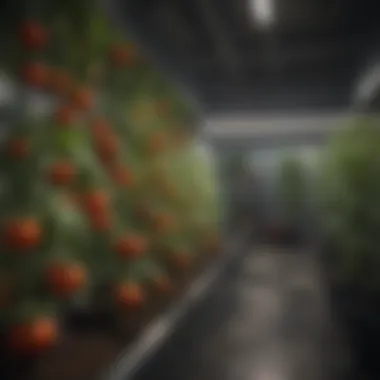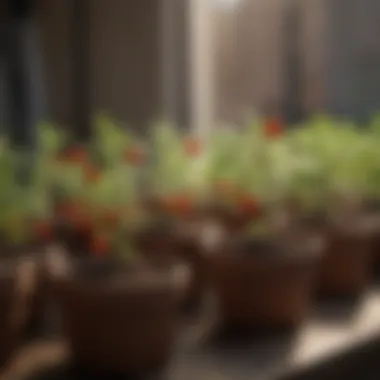Growing Cherry Tomatoes Indoors: A Complete Guide


Intro
Growing cherry tomatoes indoors is an intriguing pursuit for many, blending the art of gardening with the convenience of indoor spaces. This guide aims to elucidate the various aspects of cultivating these delectable fruits in a controlled environment. Whether you are a novice wanting to try your hand at gardening or an experienced gardener seeking to adapt to indoor conditions, there is something valuable in this guide for everyone.
The foundation of a successful indoor garden lies in understanding the specific requirements for cherry tomatoes. Key elements include light exposure, appropriate soil types, regular watering techniques, and efficient pest management. Each section will delve deep into these components, offering actionable insights that can enhance your gardening experience. Furthermore, this guide will discuss harvesting strategies to ensure a delightful yield of cherry tomatoes, satisfying both the palate and the eyes.
Design Inspirations
When growing cherry tomatoes indoors, aesthetics can complement functionality. The setup can reflect personal style while creating an engaging growing environment.
Trending Styles
Container gardening has gained popularity. Using decorative pots not only serves the purpose but can elevate the interior space. Minimalistic designs work well with small fruiting plants. Vertical gardening systems can also be integrated into the decor, utilizing wall space while providing an ample growing area.
Color Palettes
Color choices in pots and containers can enhance the look of your indoor garden. Brightly colored pots can energize the space, while muted tones might blend harmoniously with the decor. Consider selecting containers that echo the hues of ripe cherry tomatoes for a cohesive design.
Maintenance and Upkeep
Maintaining an indoor cherry tomato garden requires commitment and regular attention. Seasonal changes can bring about different care requirements which must be adhered to for optimal growth.
Seasonal Maintenance Checklist
- Spring: Start planting cherry tomato seeds indoors. Ensure adequate light exposure as days grow longer.
- Summer: Monitor for pests frequently, ensure sufficient watering as temperatures rise.
- Fall: Prepare plants for potential temperature drops. Consider using grow lights to extend the growing season.
- Winter: Check for humidity levels which can affect growth. Use heating mats if necessary to keep the roots warm.
Cleaning and Organization Tips
- Keep plant foliage clean to prevent diseases. Wipe leaves with a damp cloth regularly.
- Organize your tools and supplies in a designated area to ensure easy access when needed.
- Dispose of dead leaves and debris to maintain a healthy growing environment.
"Effective indoor gardening integrates both cultivation knowledge and aesthetic preference, creating a harmonious living space."
Understanding the balance between aesthetics and functionality when growing cherry tomatoes indoors enhances not just the gardening process, but also your living space. Adhering to the guidelines and recommendations discussed will allow for a fruitful indoor garden, sustaining the joy of harvesting cherry tomatoes all year round.
Prolusion to Indoor Gardening
Indoor gardening has seen a surge in popularity. This shift towards cultivating plants inside is driven by various factors, including limited outdoor space and the desire for fresh produce year-round. Focusing on growing cherry tomatoes in such environments can offer unique challenges and rewards.
Understanding Indoor Planting
Indoor planting allows individuals to engage with nature, even in urban settings. With careful planning, anyone can create a thriving environment for cherry tomatoes. Consider the necessity of light, water, and proper temperature. Unlike traditional gardening, the indoors present different specifications that must be met. This includes specific types of lighting and soil requirements to ensure healthy growth. When you understand these factors, the path to a successful indoor garden becomes clearer.
Benefits of Growing Cherry Tomatoes Indoors
Growing cherry tomatoes indoors presents numerous advantages. First, it provides access to fresh tomatoes throughout the year. This is especially beneficial for those in areas with short growing seasons or unfavorable weather. Indoors, the risks of pests and diseases typically found outdoors are significantly reduced. Furthermore, having an indoor garden can enhance air quality and provide a sense of personal satisfaction from nurturing something from seed to harvest.
"Indoor gardening is not merely a hobby. It transforms spaces and enriches lifestyles."
Additionally, cultivating cherry tomatoes can be a rewarding endeavor for families or individuals. It can enhance skills in cultivation, patience, and responsibility. Choosing to grow cherry tomatoes meticulously can also lead to a greater understanding of Nutrition, as you gain insight into how food is produced.
Choosing the Right Variety of Cherry Tomato
Selecting the appropriate cherry tomato variety is essential for success in indoor gardening. Each variety has distinct characteristics that may either align with or clash against a gardener’s space, preferences, and goals. Understanding the nuances between types can significantly affect yield, plant health, and overall satisfaction with the growing process.
When choosing a variety, consider the amount of available space, lighting conditions, and personal taste preferences. Some varieties may be more compact, making them suitable for smaller indoor areas, while others may require more room to flourish. Additionally, different cherry tomatoes have varying growth habits and fruit flavors, so selecting a type that suits one's taste is important for enjoyment.
Determinate vs. Indeterminate Varieties
Cherry tomatoes can be classified into two main categories: determinate and indeterminate.
- Determinate varieties are often bush-like in growth. They grow to a certain height and stop, producing all their fruit at once. This can be beneficial for indoor growers who want a concentrated harvest over a shorter period. For example, varieties such as 'Tumbling Tom' and 'Tiny Tim' are known to perform well in limited spaces.
- Indeterminate varieties continue to grow and produce fruit throughout the season. They can reach considerable heights and require support structures like stakes or cages. Varieties such as 'Sweet 100' or 'Sun Gold' are popular for their extended harvest potential. This is particularly appealing for those looking to enjoy fresh tomatoes over several months.
Both types have their benefits depending on a gardener’s preferences and capabilities. Therefore, evaluate the space and structure available before deciding on a particular type.
Popular Cherry Tomato Varieties for Indoor Growth
Several cherry tomato varieties stand out for their success in indoor environments. Here are some notable options:
- ‘Sweet 100’: Highly productive and known for its sweet flavor, this indeterminate variety can yield small, abundant tomatoes throughout the season.
- ‘Tumbling Tom’: This determinate variety is perfect for hanging baskets due to its cascading growth habit. It produces small, sweet fruit in a compact form.
- ‘Sun Gold’: Another indeterminate variety, 'Sun Gold' offers a rich, tropical flavor. Its vigorous growth can be suitable for those who can provide necessary support.
- ‘Tiny Tim’: Ideal for limited spaces, 'Tiny Tim' is a dwarf plant that can fit well on windowsills. It requires minimal care while producing tasty small tomatoes.
Choosing the right variety is just as crucial as managing their growing conditions. Consider both growing behavior and flavor to ensure a rewarding indoor gardening experience.


These varieties provide excellent flavor and adaptability to indoor settings. Choosing the right variety enhances the likelihood of fruitful gardening with cherry tomatoes indoors.
Essential Supplies for Indoor Tomato Cultivation
Understanding the necessary supplies for indoor tomato cultivation is crucial for achieving success. Cherry tomatoes, though they are relatively easy to grow, demand specific conditions and materials to thrive. By selecting the right supplies, growers can enhance the health and productivity of their plants. From containers to soil and nutrients, each component plays a vital role in the overall growth environment.
Containers and Pots
The choice of containers and pots is not merely aesthetic. It's a critical decision that impacts root health and plant growth. Indoor cherry tomatoes need good drainage to prevent root rot. Using pots with drainage holes allows excess water to escape, which is essential for preventing overwatering.
The size of the container also matters. Ideally, cherry tomatoes should be planted in pots that are at least 5-7 gallons in volume, providing sufficient space for root development. A larger pot helps stabilize the moisture level in the soil, reducing the risk of both underwatering and overwatering.
Moreover, materials for plant containers vary. Plastic pots retain moisture well but might trap more heat. Clay pots help to aerate the soil, but they may dry out faster. Consider using self-watering pots for more precise moisture control. Ultimately, the choice depends on your specific care strategy for your cherry tomatoes.
Soil Composition and Quality
Soil is the foundation of any indoor garden. For cherry tomatoes, potting soil should be rich in organic matter and nutrients. A quality mix often includes peat moss, vermiculite, and compost to promote good drainage and healthy root systems. This type of soil maintains moisture without becoming waterlogged, which is vital in an indoor environment.
In addition to texture, soil pH is critical for tomato plants. They thrive in slightly acidic conditions, ideally between 6.0 and 7.0. Testing the pH of your soil can provide insight into any necessary amendments.
If you're looking for immediate nutrients, consider adding a slow-release fertilizer to the soil at planting time. Always choose organic options when possible, as this lessens the risk of chemical exposure and can improve soil health over time.
Fertilizers and Nutrients
Nutrition is essential for indoor cherry tomato plants, especially since they grow in a limited soil volume. Regularly applying the right fertilizers can significantly enhance fruit production. Use a balanced fertilizer that has equal parts nitrogen, phosphorus, and potassium, known as N-P-K.
During the early stages of growth, focus on fertilizers high in nitrogen to promote lush foliage. As plants mature and begin to flower, switch to a formula higher in phosphorus and potassium. This adjustment supports fruit development.
Fertilizers can be applied in various forms, including granular, liquid, or organic options. Hydroponic systems may require specific nutrient solutions, so choose accordingly based on your growing method.
Regular monitoring of your plants can help identify any nutrient deficiencies. Signs such as yellowing leaves or poor fruit set may indicate that your plants need additional nutrients. Adjusting your fertilizer routine can be the key to maintaining a healthy and productive indoor tomato garden.
"A well-rounded approach to supplies ensures that your indoor garden remains robust and fruitful for a long period."
In summary, selecting proper containers, soil, and fertilizers creates a nurturing environment for your indoor cherry tomatoes. These components are essential in promoting growth, preventing diseases, and enhancing productivity.
Creating Optimal Growing Conditions
Establishing optimal growing conditions is vital for successful indoor cherry tomato cultivation. The right environment greatly influences the health and yield of the plants. Factors such as lighting, temperature, and humidity need to be closely monitored and adjusted as necessary. A thorough understanding of these elements not only enhances plant growth but also improves the quality of the tomatoes harvested.
Light Requirements: Natural vs. Artificial
Light is essential for photosynthesis, which is the process that allows plants to convert sunlight into energy. In indoor gardening, the light source can come from natural sunlight or artificial grow lights.
- Natural Light: South-facing windows are ideal for growing cherry tomatoes. The plants require about six to eight hours of direct sunlight each day. However, depending on your geographic location, the intensity and duration of sunlight can vary significantly. It is crucial to regularly assess the light exposure your plants are receiving.
- Artificial Light: If natural light is insufficient, grow lights can supplement or replace sunlight. LED and fluorescent lights are the most common choices. It’s important to place the lights close enough to the plants to be effective, typically about 12 to 18 inches away. This ensures the plants receive the necessary light without causing heat stress.
Balancing natural and artificial light creates an environment where cherry tomatoes can thrive, leading to a more fruitful harvest.
Temperature Control Strategies
Temperature plays a significant role in tomato growth. Ideally, cherry tomatoes prefer a temperature range of 70°F to 80°F during the day and around 55°F to 65°F at night. Keeping temperatures within these ranges supports optimal growth and fruiting.
Strategies for Temperature Control:
- Heating: In colder months, consider using space heaters or heat mats to maintain warmth. Heat lamps can also provide additional warmth.
- Cooling: During hotter months, ensure proper ventilation to prevent overheating. Fans can help circulate air. Also, placing plants further from heat sources is beneficial.
- Monitoring: Utilize thermometers to keep an eye on temperature changes. This awareness allows for timely adjustments.
Maintaining proper temperature is crucial as drastic fluctuations can cause stress to the plants, leading to reduced yielding and growth.
Humidity Levels and Their Importance
Humidity impacts plant health significantly. Cherry tomatoes thrive in environments that maintain around 40% to 60% humidity levels. Appropriate humidity prevents issues such as blossom end rot while promoting healthy leaf and fruit development.
Managing Humidity:
- Increase Humidity: Use a humidifier, particularly in dry seasons. Grouping plants can also create a microenvironment with higher humidity.
- Decrease Humidity: In high humidity conditions, ensure proper air circulation. Dehumidifiers can help control excess moisture.
Notice how your plants respond to humidity changes. Adjusting humidity levels accordingly leads to more robust plants and ultimately better fruit production.
Maintaining a balanced environment with ideal light, temperature, and humidity is key to successful indoor cherry tomato gardening.
Watering Practices for Indoor Tomatoes


Watering is a critical component of caring for your indoor cherry tomatoes. It affects not only the health of the plants but also their productivity. Adequate water supply ensures that the plants receive essential nutrients. However, improper watering can lead to detrimental effects. This section will explore the key aspects of watering practices, focusing on frequency, methodology, and how to identify signs of improper watering.
Watering Frequency and Methodology
Knowing when and how much to water is essential for indoor tomato cultivation. Generally, cherry tomatoes require watering when the soil feels dry an inch below the surface. This frequency can vary depending on factors like humidity, temperature, and pot size. Typically, during the growing season, watering once every two to three days may suffice. In contrast, less frequent watering is needed during colder months when the plants’ growth slows.
A methodical approach to watering can be beneficial. Here are some suggested practices:
- Use room-temperature water. Cold water can shock the roots, hindering growth.
- Water thoroughly. Make sure the water reaches deep into the soil. This encourages deeper root growth.
- Consider using drip irrigation. It provides consistent moisture without over-saturating the soil.
- Monitor moisture levels. A moisture meter can be helpful in understanding when to water.
Adapt your watering habits according to changes in the indoor climate, as these can influence water uptake.
Signs of Overwatering and Underwatering
Recognizing the symptoms of overwatering and underwatering is vital for maintaining your cherry tomato plants. Each issue presents distinct signs, helping you rectify the problem effectively.
Overwatering Symptoms:
- Yellowing leaves. Leaves may turn yellow starting from the bottom of the plant.
- Wilting. Plants that are overwatered may wilt despite being soggy.
- Root rot. This condition can lead to the death of the plant if not addressed quickly.
Underwatering Symptoms:
- Crisping leaves. Leaves may appear dry and crispy at the edges.
- Slow growth. The plants may struggle to grow and produce fruits.
- Droopy appearance. Underwatered plants will exhibit a droopy posture, signaling distress.
Understanding these signals allows you to adjust your watering practices promptly, ensuring healthy cherry tomato growth. Make it a habit to check your plants regularly. This way, you can adjust care and cultivate a thriving indoor environment.
Optimal watering practices create a foundation for a healthy indoor tomato garden. Regular monitoring and proper techniques can prevent many common issues.
Pest and Disease Management
Managing pests and diseases is a crucial aspect of growing cherry tomatoes indoors. Indoor environments can still host various pests that may damage your plants. Effective pest and disease management not only protects the plants but also ensures a bountiful harvest. Understanding common pests and preventative measures can make a difference between a thriving indoor garden and one plagued with issues.
Common Pests Affecting Indoor Tomatoes
Growing cherry tomatoes indoors does not shield them from pests. Common pests to watch for include:
- Aphids: These tiny insects can quickly infest your plants. They suck sap from the leaves, leading to yellowing and stunted growth.
- Spider Mites: Similar in appearance to tiny specks, spider mites thrive in dry conditions. They create fine webs and can damage leaves by feeding upon them.
- Whiteflies: These small, white flies tend to cluster on the undersides of leaves. They also suck sap, weakening your plants.
- Thrips: Active and tiny, these pests can cause significant damage by creating silver stripes on leaves as they feed.
Recognizing these pests early is key to successful management. Look for visible signs, such as wilting leaves or sticky residue, to help identify a problem before it escalates.
Preventative Measures and Treatment Options
Preventative measures can save time and effort in the long run. Here are a few effective strategies:
- Regular Inspection: Regularly check your plants for any signs of pests. Early detection is essential for control.
- Clean Environment: Keep your growing space clean. Remove any fallen leaves or debris, as these may attract pests.
- Companion Planting: Certain plants can deter pests. Herbs like basil and marigolds are known to repel insects while promoting growth.
- Natural Predators: Introducing beneficial insects like ladybugs can help control pest populations naturally.
If pests do appear despite preventative measures, treatment options include:
- Insecticidal Soap: This solution suffocates pests and is safe for indoor plants.
- Neem Oil: Extracted from the seeds of the neem tree, it disrupts the life cycle of pests without harming beneficial insects.
- Essential Oils: Certain oils, such as peppermint or lavender, can repel pests effectively.
Proper pest and disease management is vital for ensuring the longevity and productivity of your indoor cherry tomato plants.
Implementing these strategies can enhance the health of your indoor tomato plants and enable them to flourish in the comfort of your home. Monitoring your plants actively is key to addressing issues before they impact your harvest.
Supporting Growth: Pruning and Staking Techniques
Caring for cherry tomatoes indoors involves more than just providing adequate light and water. Supporting growth through meticulous pruning and appropriate staking is essential for ensuring healthy plants and a rich harvest. This section will delve into the significance of these practices and how they can greatly enhance both aesthetics and productivity in indoor gardening.
Importance of Pruning for Indoor Plants
Pruning is a critical practice when it comes to indoor gardening. For cherry tomatoes, this involves selectively removing parts of the plant that can impede growth or reduce yield. One of the primary reasons for pruning is to promote better air circulation among the plant's foliage. This can help reduce the likelihood of fungal diseases, common in indoor environments where humidity may be higher.
Further, pruning helps in directing the plant's energy towards fruit production rather than unnecessary foliage. By eliminating excess leaves or side shoots, gardeners encourage the plant to focus its resources on growing tomatoes, which is ultimately the goal of cultivation. Regularly trimming the plants can also contribute to a tidier appearance, making a cherry tomato setup more appealing in a home setting.
It is beneficial to prune cherry tomato plants often, as this encourages stronger growth in the remaining branches. This practice not only aids in maintaining an optimal size but also helps manage the total number of fruits, ensuring that plants are not overloaded. When plants have fewer fruits, they can allocate more nutrients to each, resulting in larger and tastier tomatoes.
Staking Solutions for Leaning Plants
As cherry tomato plants grow, they can become top-heavy and begin to lean or fall over under the weight of their fruit. Staking is an effective solution to support these plants, ensuring they remain upright and healthy. Using stakes prevents damage from leaning and allows foliage to receive adequate light.
There are various staking options available:


- Single Stakes: Insert a stake into the soil beside the plant. As the plant grows, tie the main stem loosely to the stake. This method is simple and effective for many determinate varieties.
- Cages: Tomato cages provide a cage-like support around the plant. This is ideal for indeterminate varieties that grow taller and require more support as they expand. The cage provides stability and allows for better air circulation.
- Trellis Systems: Using a trellis can work well in tighter indoor spaces. Plant vines can be guided upwards through a lattice structure, maximizing vertical space and light exposure.
Staking is not merely about support; it also ensures that the fruits are protected from soil diseases and pests, which are often attracted to damp foliage. Maintaining clean and elevated fruits can influence their overall health.
"Proper staking and pruning techniques can mean the difference between mediocre tomatoes and a bountiful harvest."
Overall, both pruning and staking are indispensable techniques for anyone growing cherry tomatoes indoors. These practices not only contribute to plant health but also enhance the gardening experience, allowing enthusiasts to enjoy a fruitful and thriving indoor garden.
Harvesting Your Indoor Cherry Tomatoes
Harvesting your cherry tomatoes is a crucial step in the indoor gardening process. Understanding when and how to harvest can greatly influence the flavor and quality of the tomatoes, which is essential for any gardener. This section delves into the specifics of harvesting and its many benefits, including taste enhancement and extended production. Knowing the signs that indicate readiness for picking can help ensure that the fruits are at their peak.
Identifying the Right Time to Harvest
To ensure optimal flavor and ripeness, it is vital to identify the right time to harvest cherry tomatoes. Generally, this can be done by observing the color and firmness of the tomatoes. A common indication is when the tomatoes have changed from green to a vivid hue, typically depending on the variety—often red, yellow, or even orange.
When touching the fruit, a slight give can indicate that the tomatoes are ready. Ripe tomatoes will often come off the vine with minimal pressure. It's recommended to check daily as harvest time approaches because cherry tomatoes can ripen quickly.
There are also specific indicators throughout the growing season. For example, breathing some warmth can suggest ripeness. As the season progresses, ensure to monitor your plants closely.
Methods of Harvesting and Preserving Tomatoes
Harvesting cherry tomatoes can be done carefully to avoid damaging the plant. A simple twist or cut can work well for removing the fruit. Here are some methods to consider:
- Using Clean Shears or Scissors: This method is ideal for larger crops and prevents injury to the plant.
- Pinching Off the Stem: For smaller gardens or fewer tomatoes, pinching carefully can help in harvesting.
- Harvesting in the Early Morning: It is best to harvest tomatoes in the cooler part of the day. This preserves freshness and prevents wilting.
Once harvested, it is essential to store the tomatoes properly to maintain their flavor. Here are some ways to preserve your cherry tomatoes:
- Refrigeration: Ideally used for short-term storage, refrigeration can extend the freshness.
- Room Temperature: Leaving tomatoes at room temp allows them to develop their unique flavors.
- Drying: Sun-drying tomatoes is another option that intensifies flavor.
- Freezing: For long-term storage, freezing can be effective, but ensure they are well-protected to avoid freezer burn.
“Properly harvested cherry tomatoes can elevate your culinary experiences.”
Taking care of these harvesting practices will lead to a successful indoor tomato garden and a delicious outcome.
Seasonal Considerations for Indoor Tomato Growth
Understanding seasonal changes is essential for indoor tomato gardening. Each season presents unique challenges and opportunities that can affect the growth of cherry tomatoes. Adapting care practices to these seasonal shifts not only promotes healthier plants but also maximizes yield. Indoor gardens are not insulated from seasonal effects. Factors like light duration, temperature variations, and humidity levels influence plant development significantly, even in controlled environments.
The following points highlight the relevance of adjusting care based on the season:
- Light Intensity: Indoor light levels can shift with the seasons. The days are shorter in winter, requiring more artificial light to compensate for natural light deficiencies.
- Temperature Fluctuations: Understanding the temperature requirements for cherry tomatoes is crucial. Plants may require more warmth during colder months to thrive.
- Humidity Control: Relative humidity often decreases in winter. Maintaining an adequate level of humidity is important for preventing stress in plants.
In summary, seasonal considerations play a pivotal role in cultivating cherry tomatoes indoors. By recognizing and responding to these seasonal shifts, gardeners can create an optimal growing environment that supports robust plant growth.
Adjusting Care Through Seasonal Changes
Adapting your care routine throughout the year is crucial when growing cherry tomatoes indoors. Each season brings different conditions that can influence plant health and productivity. To ensure success, modify the following care aspects accordingly:
- Lighting: In winter, it may be necessary to increase the time your plants receive artificial light, as natural sunlight is limited. Consider using full-spectrum grow lights for an extended period each day.
- Watering Practices: Water requirements may change with the season. During colder months, plants may need less water due to reduced evaporation rates. Observe the moisture levels closely.
- Fertilization: Schedule fertilization based on growth phases. In spring and summer, regular feeding is essential, but during dormancy in winter, reduce the frequency to prevent nutrient buildup.
Indoor Gardening During Winter Months
Winter presents particular challenges for indoor tomato growers. The lack of natural light and lower indoor temperatures can hinder growth unless addressed properly. Here are some important strategies to implement:
- Supplementing Light: Use grow lights to provide adequate light for photosynthesis. A timer can help manage daily exposure, offering 12 to 16 hours of light reserved for peak growth.
- Temperature Management: Keep the indoor temperature stable. Aim for consistent warmth, ideally between 65 to 75 degrees Fahrenheit. Use a space heater if necessary, but avoid direct drafts on the plants.
- Humidity Levels: To combat dry winter air, consider using a humidifier or placing trays of water near your plants. Misting can also help, but do so cautiously to avoid water accumulation on leaves.
By establishing these care adjustments, gardeners can create a conducive environment that allows cherry tomatoes to flourish, even during the winter months.
Ending and Future Considerations
Reflecting on the journey of growing cherry tomatoes indoors, several key themes emerge. This ultimate guide aims not just to instruct but to inspire a deeper appreciation for urban gardening. The process encompasses nurturing plants, monitoring growth, and adapting to challenges. Each stage contributes to understanding the delicate balance of creating conducive environments for plants.
Evaluating Success in Indoor Gardening
Success in indoor gardening is often measured by yield and plant health. It involves assessing every aspect of the growth cycle. Regular self-assessment is crucial. Consider factors such as:
- Plant Appearance: Healthy cherry tomato plants exhibit vibrant leaves and robust stems. If they look lackluster, adjustments may be necessary.
- Fruit Quality: Monitor the size, flavor, and ripeness of your tomatoes. Quality indicates proper care.
- Frequency of Issues: Frequent pest attacks or disease outbreaks can signal need for improvement in management practices.
Using these criteria provides a framework for evaluating effectiveness in indoor gardening. Documenting results helps tailor future efforts and can enhance overall productivity.
Expanding Your Indoor Garden: Additional Plants to Consider
Once comfortable with cherry tomatoes, expanding the indoor garden can be an enriching experience. A diverse garden can lead to varied benefits, such as visual appeal and different flavors. Here are some suitable options for indoor planting:
- Herbs: Basil and mint thrive indoors. Their compact growth patterns suit limited spaces and offer culinary benefits.
- Lettuce: Fast-growing and low-maintenance, lettuce can complement your tomato harvest nicely.
- Peppers: Jalapeño or sweet peppers can also flourish indoors and provide versatility.
When considering additional plants, reflect on light requirements and space availability. Mixing crops can create an engaging indoor garden while promoting biodiversity.
By nurturing both cherry tomatoes and companion plants, the indoor gardener can enjoy a more holistic gardening experience, contributing not only to aesthetics but also to sustainability.







